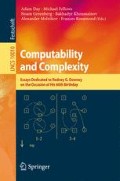Abstract
We consider the strength and effective content of restricted versions of Hindman’s Theorem in which the number of colors is specified and the length of the sums has a specified finite bound. Let \(\mathsf {HT}^{\le n}_k\) denote the assertion that for each k-coloring c of \(\mathbb {N}\) there is an infinite set \(X \subseteq \mathbb {N}\) such that all sums \(\sum _{x \in F} x\) for \(F \subseteq X\) and \(0 < |F| \le n\) have the same color. We prove that there is a computable 2-coloring c of \(\mathbb {N}\) such that there is no infinite computable set X such that all nonempty sums of at most 2 elements of X have the same color. It follows that \(\mathsf {HT}^{\le 2}_2\) is not provable in \(\mathsf {RCA}_0\) and in fact we show that it implies \(\mathsf {SRT}^2_2\) in \(\mathsf {RCA}_0+ \mathsf {B}\Pi ^0_1\). We also show that there is a computable instance of \(\mathsf {HT}^{\le 3}_3\) with all solutions computing \(0'\). The proof of this result shows that \(\mathsf {HT}^{\le 3}_3\) implies \(\mathsf {ACA}_0\) in \(\mathsf {RCA}_0\).
This paper is dedicated to Rod Downey in honor of his outstanding contributions to computability theory and his leadership role in mentoring and exposition. Two of the authors had the pleasure of being mentored by Rod as postdocs.
Dzhafarov was partially supported by NSF grant DMS-1400267. Jockusch thanks his coauthors for their hospitality during a visit to the University of Connecticut in May, 2015, during which the work in this paper was largely done. His visit was supported by the University of Connecticut Department of Mathematics. The authors thank Denis Hirschfeldt for numerous valuable insights.
Access this chapter
Tax calculation will be finalised at checkout
Purchases are for personal use only
References
Baumgartner, J.E.: A short proof of Hindman’s theorem. J. Comb. Theor. Ser. A 17, 384–386 (1974)
Blass, A.R., Hirst, J.L., Simpson, S.G.: Logical analysis of some theorems of combinatorics and topological dynamics In: Logic and Combinatorics (Arcata, California, 1985). Contemporary Mathematics, American Mathematical Society, Providence R.I., vol. 65, pp. 125–156 (1987)
Chong, C.T., Lempp, S., Yang, Y.: On the role of the collection principle for \(\Sigma _2\) formulas in second-order reverse mathematics. Proc. Am. Math. Soc. 138, 1093–1100 (2010)
Comfort, W.W.: Ultrafilters: some old and some new results. Bull. Am. Math. Soc. 83, 417–455 (1977)
Cholak, P.A., Jockusch, C.G., Slaman, T.A.: On the strength of Ramsey’s Theorem for pairs. J. Symbolic Logic 66, 1–55 (2001)
Hindman, N.: Finite sums from sequences within cells of a partition of \(\mathbb{N}\). J. Comb. Theor. Ser. A 17, 1–11 (1974)
Hindman, N., Leader, I., Strauss, D.: Open problems in partition regularity. Comb. Probab. Comput. 12, 571–583 (2003)
Jockusch, C.: Ramsey’s theorem and recursion theory. J. Symbolic Logic 37, 268–280 (1972)
Rumyantsev, A., Shen, A.: Probabilistic constructions of computable objects and a computable version of Lovász local lemma. Fund. Inform. Russ. Finnish Symp. Discrete Math. 132, 1–14 (2014)
Simpson, S.: Subsystems of Second Order Arithmetic, 2nd edn. Cambridge University Press, Association for Symbolic Logic, New York (2009)
Soare, R.I.: Recursively Enumerable Sets and Degrees. Perspectives in Mathematical Logic. Springer, Heidelberg (1987)
Towsner, H.: A simple proof and some difficult examples for Hindman’s Theorem. Notre Dame J. Formal Logic 53(1), 53–65 (2012)
Author information
Authors and Affiliations
Corresponding author
Editor information
Editors and Affiliations
Rights and permissions
Copyright information
© 2017 Springer International Publishing AG
About this chapter
Cite this chapter
Dzhafarov, D.D., Jockusch, C.G., Solomon, R., Westrick, L.B. (2017). Effectiveness of Hindman’s Theorem for Bounded Sums. In: Day, A., Fellows, M., Greenberg, N., Khoussainov, B., Melnikov, A., Rosamond, F. (eds) Computability and Complexity. Lecture Notes in Computer Science(), vol 10010. Springer, Cham. https://doi.org/10.1007/978-3-319-50062-1_11
Download citation
DOI: https://doi.org/10.1007/978-3-319-50062-1_11
Published:
Publisher Name: Springer, Cham
Print ISBN: 978-3-319-50061-4
Online ISBN: 978-3-319-50062-1
eBook Packages: Computer ScienceComputer Science (R0)

